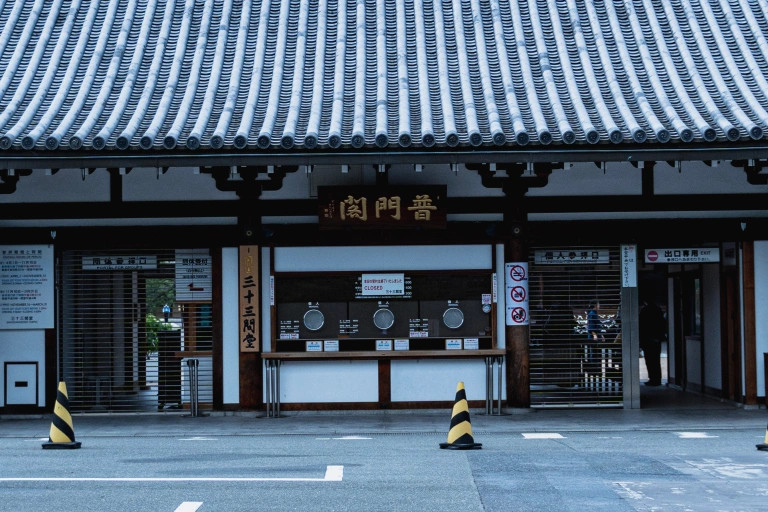
And it was his first time visiting, too!
Sanjusangen-do, officially known as Rengeo-in, is a pretty famous temple among Japanese citizens and international tourists alike. The Kyoto Buddhist temple, which has been ranked in the top 30 sightseeing spots for tourists on Trip Advisor, is famous for its rows upon rows of 1,032 Buddhist statues. According to our Japanese-language reporter Tasuku Egawa, probably about 90 percent of school kids visit this temple during their school field trip to Kyoto–so just about everyone knows about it.
But Tasuku, now 40 years old, has only just visited for the first time. He happened to be invited on a press tour held by Central Japan Railway that showcased this year’s Buddhist statue-themed “Sou da Kyoto, Ikou” promotion for Kyoto, and one of the stops was Sajusangen-do.
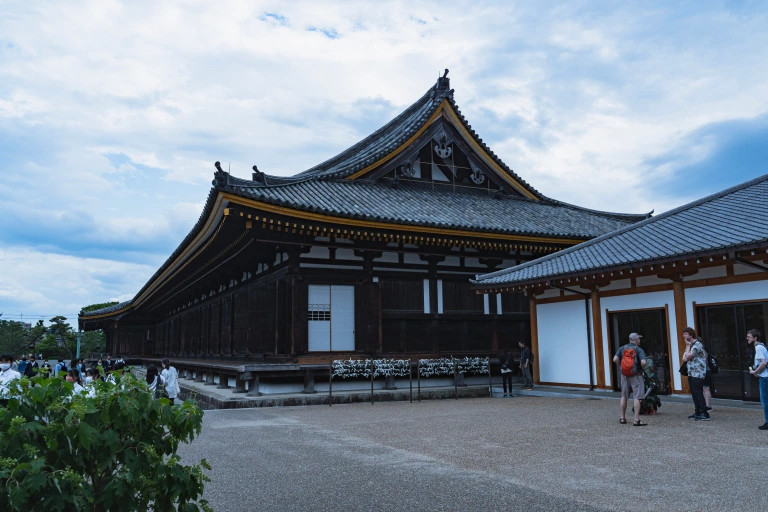
Image © SoraNews24
Inside, the temple was packed with students on field trips. Tasuku mused that it must really be a staple in schools’ itineraries, but for some reason, it hadn’t been a stop on his school’s field trip. In fact, even though his school trip took him to Nara and Kyoto, they didn’t go to a single temple.
Why? Because they spent about 80 percent of their time in Nara, being forced to peddle around on rusty bicycles in the pouring rain to an unknown burial mound in the midst of a field out in the middle of nowhere, which they had to sketch on their sopping wet sketchpads for some reason.
They spent the remaining 20 percent of the time in Kyoto, eating ramen at some ramen shop in front of Kyoto Station and only getting to see the sign in front of the famous Kiyomizudera Temple before the time was up and they had to go home. It was the weirdest and most pointless school trip ever, and young Tasuku decided to commemorate it with a suitably weird souvenir, a 2,000-yen (currently US$13.94) ski mask.
Now, as an adult, all of the kids exploring Sanjusangen-do on their fun-looking school trip couldn’t help but remind Tasuku about how salty he still is about that. It’s such a special thing to get to see such a splendid display of statues at such an impressionable young age–and he didn’t get to experience that.
Still, for Tasuku, who was seeing it for the first time at 40, the place was fascinating. But as his eyes trailed over the many statues on display, he couldn’t help one thought that popped up:
“How could anyone ever see the ones in the back?”
Each and every statue is different, and each and every one is also considered a national treasure. If that’s the case, Tasuku would have wanted to see all of them, even the ones in the back.
It turns out you actually can! Using the “National Treasure Sentai Senju Kannon Standing Statues, The 28 Legions, and the Fujin and Raijin Statues Search System,” you can browse all 1,032 statues in detail, with descriptions in both English and Japanese.
▼ The Search System as shown on the temple’s website
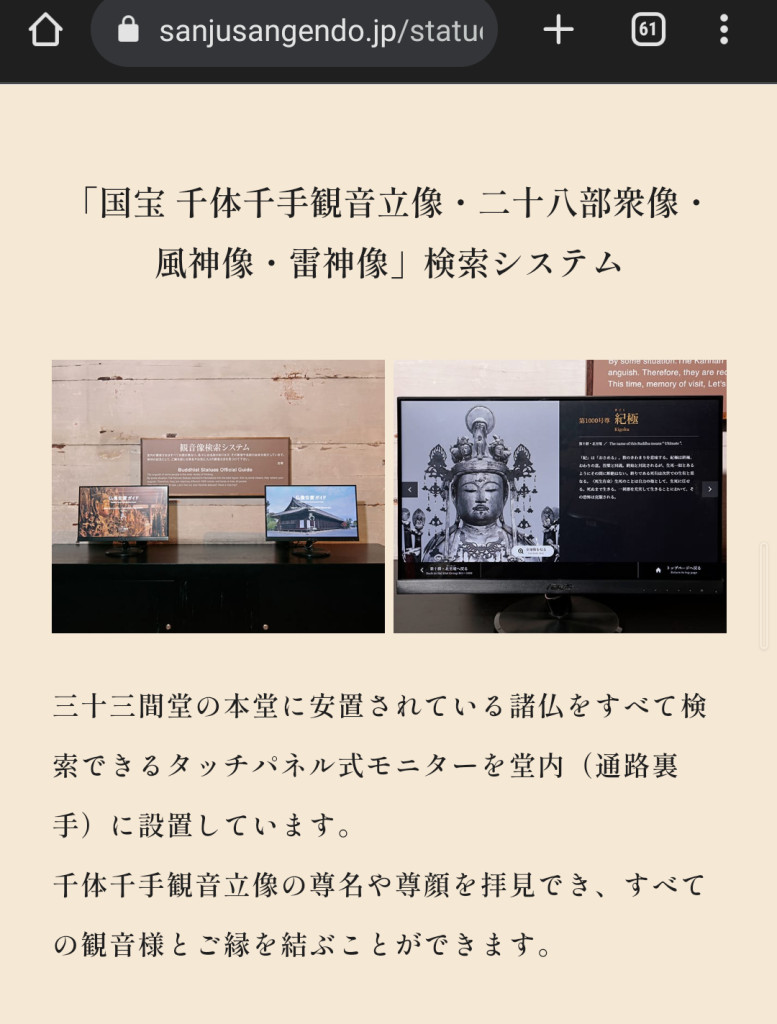
Screenshot from Sanjusangen-do
On the path behind the principal object of worship, a small computer station is set up with monitors on a counter. The screens portray a map of each of the statues and their exact placement, and you can use the touch screen to navigate between them and see pictures of each one, as well as learn more about it.
Since photography is not allowed within the facility, Tasuku had to memorize the setup on the screen and then draw it out in the blank spaces of his pamphlet when he went back outside. The main screen looked a bit like this:
▼ The real thing had more detail, with statue names included, but Tasuku’s memory doesn’t stretch so far.
From this screen, if you tapped on “Group No. 1”, it would show the 100 statues included in that group, from which you can select one to learn more details about it. The thing that really shocked Tasuku when he used this feature was the fact that all 1,000 of the Kannon statues each have their own name. He couldn’t help but wonder how they came up with so many.
The other thing Tasuku came to realize with a jolt was that, because there are so many statues, this system must contain a huge database of information. Tasuku had no idea how such a thing would have been created, but he was so dumbfounded by the sheer passion needed to do so that he actually laughed out loud.
Sadly, perhaps because the computer station just doesn’t stand out, most tourists seemed to ignore it. Tasuku had to doubt that there was any person out there who had read through the page for each statue, which had to mean that there could also be a page that has never been read by anyone (except maybe the people who made it).
That’s an absolute shame! More people should know about this feature and take advantage of it. If you happen to visit Sanjusangen-do, definitely check it out!
▼ The temple workers also give very interesting talks about the temple, its statues, and the building’s construction.
And while you’re in Kyoto, don’t forget to try a modern local delicacy, tomato okonomiyaki, or treat yourself to the Ultimate Matcha Float!
Related: Sajusangen-do, Souda Kyoto, Ikou
Top image ©SoraNews24
Insert images provided by Central Japan Railway (except where noted)
● Want to hear about SoraNews24’s latest articles as soon as they’re published? Follow us on Facebook and Twitter!

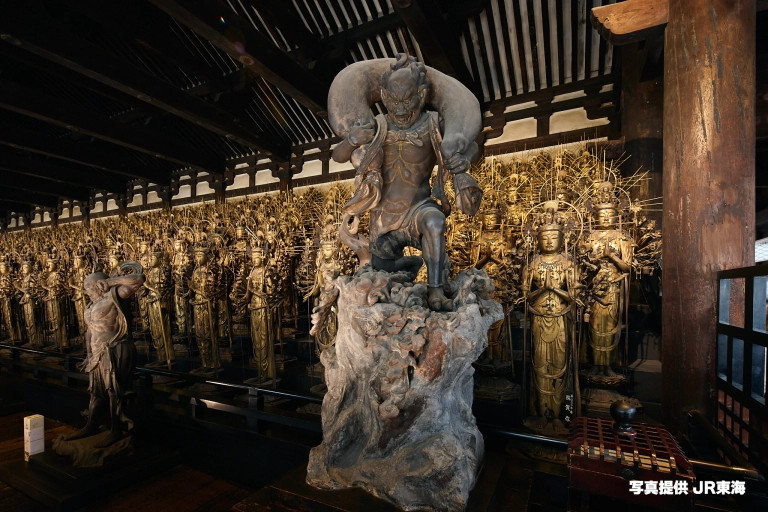
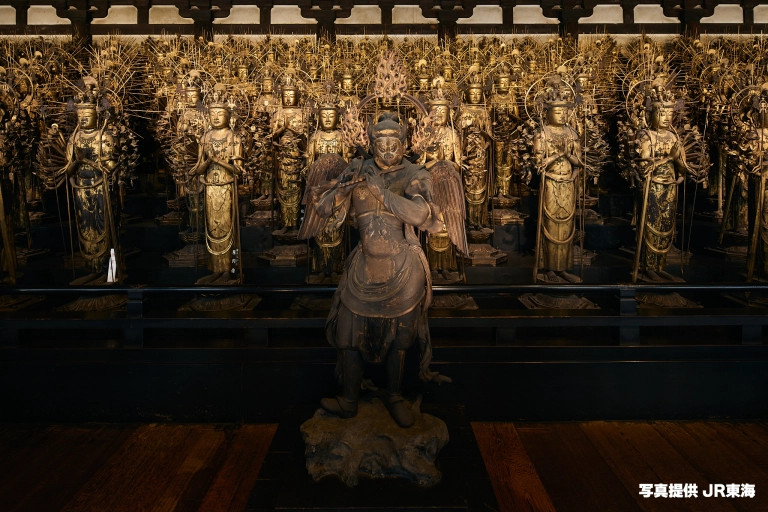
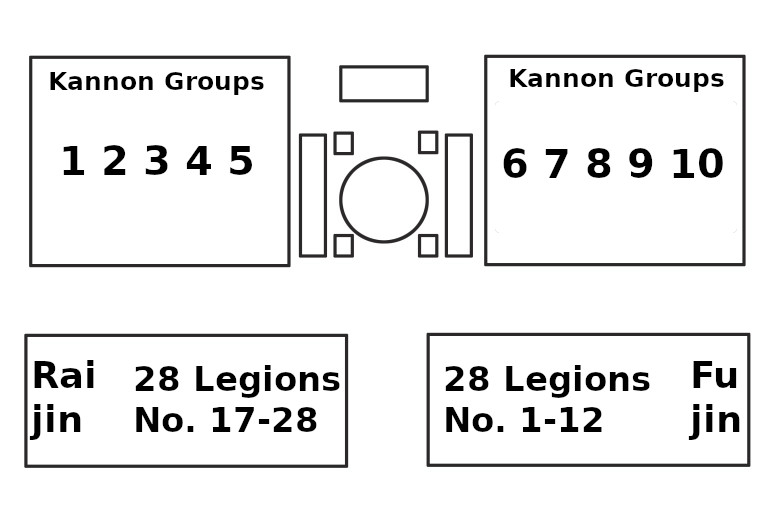
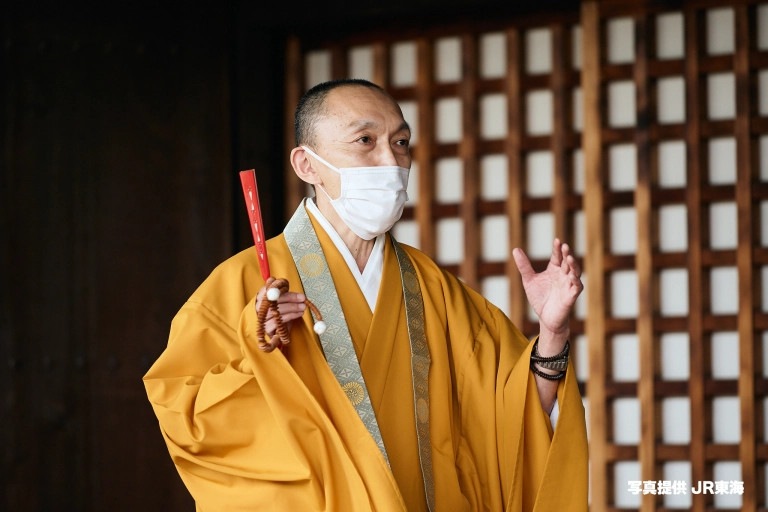
 Kyoto in summer: A special trip to Kifune shrine recharges the soul
Kyoto in summer: A special trip to Kifune shrine recharges the soul Can you really learn to draw Totoro from that 61-second Studio Ghibli producer video?【Experiment】
Can you really learn to draw Totoro from that 61-second Studio Ghibli producer video?【Experiment】 We tried every single flavor of Mister Donut’s Belgian chocolatier collab donuts【Taste test】
We tried every single flavor of Mister Donut’s Belgian chocolatier collab donuts【Taste test】 We travel across the city like royalty — Hiroshima streetcar turns into fancy, private dining area
We travel across the city like royalty — Hiroshima streetcar turns into fancy, private dining area Defibrillator toys from Japanese capsule machines are so realistic they might save a life
Defibrillator toys from Japanese capsule machines are so realistic they might save a life Foreigner’s request for help in Tokyo makes us sad for the state of society
Foreigner’s request for help in Tokyo makes us sad for the state of society Japanese-style accommodation at the new Premium Dormy Inn hotel in Asakusa will blow your mind
Japanese-style accommodation at the new Premium Dormy Inn hotel in Asakusa will blow your mind Seaside scenery, history, and so many desserts on Yokohama’s Akai Kutsu【Japan Loop Buses】
Seaside scenery, history, and so many desserts on Yokohama’s Akai Kutsu【Japan Loop Buses】 Japanese city loses residents’ personal data, which was on paper being transported on a windy day
Japanese city loses residents’ personal data, which was on paper being transported on a windy day Mikado Coffee is a 76-year-old coffee chain with a major celebrity connection
Mikado Coffee is a 76-year-old coffee chain with a major celebrity connection Japanese ramen restaurants under pressure from new yen banknotes
Japanese ramen restaurants under pressure from new yen banknotes Japan’s summertime towelket pillowcases are even better with the addition of Ghibli stars【Photos】
Japan’s summertime towelket pillowcases are even better with the addition of Ghibli stars【Photos】 Suntory x Super Mario collaboration creates a clever way to transform into Mario【Videos】
Suntory x Super Mario collaboration creates a clever way to transform into Mario【Videos】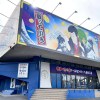 A visit to the best UFO catcher arcade in the universe!
A visit to the best UFO catcher arcade in the universe! The results are in! One Piece World Top 100 characters chosen in global poll
The results are in! One Piece World Top 100 characters chosen in global poll McDonald’s new Happy Meals offer up cute and practical Sanrio lifestyle goods
McDonald’s new Happy Meals offer up cute and practical Sanrio lifestyle goods French Fries Bread in Tokyo’s Shibuya becomes a hit on social media
French Fries Bread in Tokyo’s Shibuya becomes a hit on social media Red light district sushi restaurant in Tokyo shows us just how wrong we were about it
Red light district sushi restaurant in Tokyo shows us just how wrong we were about it New private rooms on Tokaido Shinkansen change the way we travel from Tokyo to Kyoto
New private rooms on Tokaido Shinkansen change the way we travel from Tokyo to Kyoto Tokyo Tsukiji fish market site to be redeveloped with 50,000-seat stadium, hotel, shopping center
Tokyo Tsukiji fish market site to be redeveloped with 50,000-seat stadium, hotel, shopping center Beautiful Ghibli sealing wax kits let you create accessories and elegant letter decorations【Pics】
Beautiful Ghibli sealing wax kits let you create accessories and elegant letter decorations【Pics】 Secret Kitchen bento serves Japanese flowers, birds, wind and moon in a box, but is it worth it?
Secret Kitchen bento serves Japanese flowers, birds, wind and moon in a box, but is it worth it? New definition of “Japanese whiskey” goes into effect to prevent fakes from fooling overseas buyers
New definition of “Japanese whiskey” goes into effect to prevent fakes from fooling overseas buyers Our Japanese reporter visits Costco in the U.S., finds super American and very Japanese things
Our Japanese reporter visits Costco in the U.S., finds super American and very Japanese things Studio Ghibli releases Kiki’s Delivery Service chocolate cake pouches in Japan
Studio Ghibli releases Kiki’s Delivery Service chocolate cake pouches in Japan All-you-can-drink Starbucks and amazing views part of Tokyo’s new 170 meter-high sky lounge
All-you-can-drink Starbucks and amazing views part of Tokyo’s new 170 meter-high sky lounge More foreign tourists than ever before in history visited Japan last month
More foreign tourists than ever before in history visited Japan last month New Pokémon cakes let you eat your way through Pikachu and all the Eevee evolutions
New Pokémon cakes let you eat your way through Pikachu and all the Eevee evolutions Disney princesses get official manga makeovers for Manga Princess Cafe opening in Tokyo
Disney princesses get official manga makeovers for Manga Princess Cafe opening in Tokyo Sales of Japan’s most convenient train ticket/shopping payment cards suspended indefinitely
Sales of Japan’s most convenient train ticket/shopping payment cards suspended indefinitely Sold-out Studio Ghibli desktop humidifiers are back so Totoro can help you through the dry season
Sold-out Studio Ghibli desktop humidifiers are back so Totoro can help you through the dry season Japanese government to make first change to romanization spelling rules since the 1950s
Japanese government to make first change to romanization spelling rules since the 1950s Ghibli founders Toshio Suzuki and Hayao Miyazaki contribute to Japanese whisky Totoro label design
Ghibli founders Toshio Suzuki and Hayao Miyazaki contribute to Japanese whisky Totoro label design Doraemon found buried at sea as scene from 1993 anime becomes real life【Photos】
Doraemon found buried at sea as scene from 1993 anime becomes real life【Photos】 Tokyo’s most famous Starbucks is closed
Tokyo’s most famous Starbucks is closed One Piece characters’ nationalities revealed, but fans have mixed opinions
One Piece characters’ nationalities revealed, but fans have mixed opinions We asked a Uniqlo employee what four things we should buy and their suggestions didn’t disappoint
We asked a Uniqlo employee what four things we should buy and their suggestions didn’t disappoint We tried super spicy wasabi ramen and yakisoba that’s rumored to make anyone cry【Taste Test】
We tried super spicy wasabi ramen and yakisoba that’s rumored to make anyone cry【Taste Test】 How to pick out the best anago eel and other things we learned at the anago processing center
How to pick out the best anago eel and other things we learned at the anago processing center Trying the peach custard treat in Japan that got over 20 thousand likes in a week
Trying the peach custard treat in Japan that got over 20 thousand likes in a week Giant Buddhist pagoda and Kannon statue in Fukuoka Prefecture look like a theme park
Giant Buddhist pagoda and Kannon statue in Fukuoka Prefecture look like a theme park All-Noodle Artisan Marugame udon restaurant operating in Tokyo, only 30 percent pass test
All-Noodle Artisan Marugame udon restaurant operating in Tokyo, only 30 percent pass test Mister Donut’s new Angel Fruit series elevates angel cream doughnuts, takes taste buds to heaven
Mister Donut’s new Angel Fruit series elevates angel cream doughnuts, takes taste buds to heaven We try fresh orange juice squeezed for us by a vending machine in Saitama【Taste test】
We try fresh orange juice squeezed for us by a vending machine in Saitama【Taste test】 We learned how to make a calligraphy brush from the masters of Kumanofude in Hiroshima
We learned how to make a calligraphy brush from the masters of Kumanofude in Hiroshima Japanese convenience store’s cheap knockoff croissant — is it any good?
Japanese convenience store’s cheap knockoff croissant — is it any good? We fall in love with a bucket of Japanese custard pudding【Taste test】
We fall in love with a bucket of Japanese custard pudding【Taste test】 We try the four new offerings in the Mister Donut x Gion Tsujiri collaboration series【Taste test】
We try the four new offerings in the Mister Donut x Gion Tsujiri collaboration series【Taste test】 Trying out First Kitchen’s tsukimi mochi burgers for a taste of Japanese autumn
Trying out First Kitchen’s tsukimi mochi burgers for a taste of Japanese autumn Can this cushion really protect an egg from being sat on? How about a few punches?
Can this cushion really protect an egg from being sat on? How about a few punches? McDonald’s Japan’s Samurai Mac series: which burger is the greatest warrior of all?
McDonald’s Japan’s Samurai Mac series: which burger is the greatest warrior of all? Godiva creates a new drink with Japanese sake starter
Godiva creates a new drink with Japanese sake starter
Leave a Reply